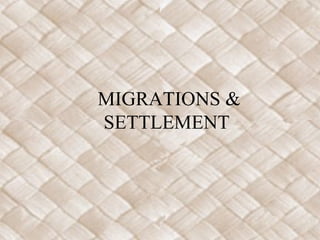
Migrations and settlement
- 2. MIGRATION • Circa 1600-1200 B.C. Lapita culture spread from Papua New Guinea in Melanesia as far east as Fiji, Sāmoa & Tonga • Circa 300 B.C., seafarers from Sāmoa and Tonga discovered and settled islands to the east (Cook Islands, Tahiti, Tuamotu, Marquesas) • Circa 300 A.D., voyagers from central or eastern Polynesia discovered and settled Rapa Nui (Easter Island) • Circa 400 A.D., voyagers from the Cook Islands, Tahiti and/or Marquesas settled Hawai`i • Circa 1000 A.D., voyagers from the Society and/or Cook Islands settled Aotearoa (New Zealand)
- 3. MIGRATIONS & SETTLEMENT • Migration theories are tested through: – Science – Linguistics – Genealogies/oral traditions
- 4. SCIENCE • Radio-carbon dating of charcoal • Archaeological findings – Lapita
- 5. LINGUISTICS • The scientific study of language and its structure, including the study of morphology, syntax, phonetics, and semantics.
- 6. GENEALOGIES & ORAL TRADITIONS • Menehune • Hawai`inui • Hawai`iloa • Sequence of migrations from Tahiti – Kapawa led the first – Pā`ao & Makuakaumana follwed
- 7. CHANT
- 8. WAYFINDING
- 9. If you have any questions, please ask them on the Discussion Board. Mahalo!
- 10. If you have any questions, please ask them on the Discussion Board. Mahalo!
Notas do Editor
- Migratory or canoe traditions tell of the departure from islands of origin and the arrival, exploration and settlement in new locales. Migratory traditions have been the subject of much attention and speculation as there are several theories regarding migration to Hawaii. While dates constantly change with new archaeological discoveries, the general sequence for the settlement of Polynesia has been relatively well established (Dates represent earliest archaeological finds; they almost certainly do not represent the earliest presence of human beings.
- linguistics (the study of language and its changes), genealogies and oral traditions
- Polynesians peoples are united by common language, culture and distinctive genetics Theories are tested through science (radio-carbon dating using charcoal from the earliest imu or cooking sites to determine the age of the specimen) Lapita is a term applied to an ancient Pacific Ocean archaeological culture which is believed by many archaeologists to be the common ancestor of several cultures in Polynesia, Micronesia, and some coastal areas of Melanesia. Lapita is believed to have originated on the islands of South East Asia, perhaps in the Moluccas and Indonesia as some archeology indicates. One of the earliest, securely dated sites with Lapita Pottery is dated to 1650 B.C and is on Nissan in the Bismark Archipelago. The earliest detectable migrations of the Lapita are on the islands of the Bismark Archipelago in Near Oceania which were settled c. 1500 B.C.Moving rapidly in small groups, the Lapita people penetrated Remote Oceania, then traveled to Fiji and West Polynesia from Melanesia between 1200 and 1,000 B.C. Their ocean voyaging traversed remarkable mileage. In no more than 10 generations, they reached Tonga and Samoa by 1,000 B.C. In the end, the most eastern site for Lapita archaeological remains recovered so far has been through work on the archaeology in Sam More archaeological evidence is needed from Hawai'i, Hiva and other islands of Polynesia before any definitive statements can be made about the relationship among the island groups during the period of the early settlement of Hawai'i.
- Polynesian languages show a considerable degree of similarity. Scholars believe that early settlers of Hawai'i came predominantly from Hiva (Marquesas). The argument for a Hivan homeland is based in part on linguistic and biological evidence: "Indeed, the close relationship between the Hawaiian and Marquesan languages as well as between the physical populations constitutes strong and mutually corroborative evidence that the early Hawaiians came from the Marquesas Vocabulary comparisons seem to indicate that the dialect of the Southern Marquesan Islands (Hiva Oa, Tahuata, Fatu Hiva), is the closest relative of Hawaiian language One scholar (Kenneth Emory) has noted that some words in the Hawaiian language (such as the names of some days in the lunar month) are shared uniquely with the Tahitian language, suggesting settlers to Hawai'i came from Tahiti as well as the Marquesas. The ancestors of the Polynesians relocated ancient place names as they migrated from island to island.
- One first arrival tradition/theory refer to an earlier Hawaiian population known as the menehune. This is a term also known in Tuamotu, Tahiti & the Rarotonga. Another tradition tells of a canoe named Hawai`inui from Kahiki that carried the first settlers. Another tells us that Hawai`iloa was the first settler Other arrival traditions trace a sequence of migrations from Tahiti.
- This tradition tells us that the navigator Mo`ikeha named the Big Island Hawai`i through this chant.
- Navigators traveled to small, inhabited islands using only their own senses and knowledge passed by oral tradition from navigator to apprentice. In order to locate directions at various times of day and year, navigators in Eastern Polynesia memorized important facts: the motion of specific stars and where they would rise on the horizon of the ocean; weather; times of travel; wildlife species (which congregate at particular positions); directions of swells on the ocean and how the crew would feel their motions; colors of the sea and sky, and how clouds would cluster at the locations of some islands. These wayfinding techniques, along with outrigger canoe construction methods were kept as guild secrets. Generally each island and/or island group maintained a guild of navigators who had very high status. Unfortunately, knowledge of the traditional Polynesian methods of navigation were largely lost after contact with and colonization by Europeans. Recent recreations of Polynesian voyaging have used methods based largely on Micronesian methods and the teachings of a Micronesian navigator, affectionately known as Papa Mau.